New Mexico, known as the ‘Land of Enchantment,’ boasts varied landscapes from vast deserts to high mountain peaks. The sprawling landscapes of New Mexico, encompassing the Rocky Mountains and the dense forests of the Rio Grande Valley, are home to a remarkable assortment of avian wonders.
Among the birds of New Mexico, the brightly colored orange varieties stand out, frequently spotted fluttering between large trees and scattered trees in both city parks and mixed woods. In this guide, we’ll explore 10 stunning orange birds that grace the Land of Enchantment, making it a birdwatcher’s paradise.
Orange Birds Found In New Mexico
The state’s diverse geography, encompassing arid plains, lush river valleys, and soaring altitudes, creates a plethora of habitats attracting a vast array of bird species. The climatic contrasts and unique ecosystems, from the Chihuahuan Desert to the Sangre de Cristo Mountains, provide niches for both migratory and resident birds, making New Mexico a bird-watcher’s paradise.
Baltimore Oriole


| Feature | Measurement |
|---|---|
| Scientific Name | Icterus galbula |
| Length | 6.7–8.7 in |
| Wingspan | 9.1–12.6 in |
| Weight | 22.3-42 g |
The Baltimore Oriole is a stunning bird, best known for its vibrant coloration and its rich, whistling song.
Appearance: The male Baltimore Oriole is notable for his bright orange and black plumage and black and white wing bars, a stark contrast to the more muted yellow-brown coloration of the female. Both sexes, however, have long pointed bills and white bars on their wings.
Diet: Baltimore Orioles have a diverse diet that includes insects, fruits, and nectar. Their preference for sweet juices and fruit pulp often brings them to backyard feeders offering oranges and jelly.
Reproduction: The female Baltimore Oriole is responsible for building the distinctive hanging nest, often woven together from fine materials like hair and grass. These nests are usually high in trees to avoid predators. The female lays 3-7 eggs, which are incubated for about two weeks.
American Redstart


| Feature | Measurement |
|---|---|
| Scientific Name | Setophaga ruticilla |
| Length | 4.3 to 5.5 in |
| Wingspan | 6.3 to 9.1 in |
| Weight | 8.6 g |
The American Redstart is a lively warbler known for its vivid colors and active hunting style, often seen flitting about, fanning its tail to startle and catch insects.
Appearance: Adult male American Redstarts boast striking black plumage with bright orange patches on the sides, wings, and tail. Females and immature males have grayish-olive upperparts with yellow patches in the same areas where the males display orange.
Diet: American Redstarts are primarily insectivores. They actively forage for flying insects, as well as caterpillars and spiders, often using their colorful tails to startle prey and make them easier to catch.
Reproduction: The female American Redstart builds a cup-shaped nest in the fork of a tree branch. Typically, she lays a clutch of 3 to 5 eggs. The female takes on the primary responsibility of incubating the eggs, while both parents participate in feeding the fledglings after they hatch.
Spotted Towhee

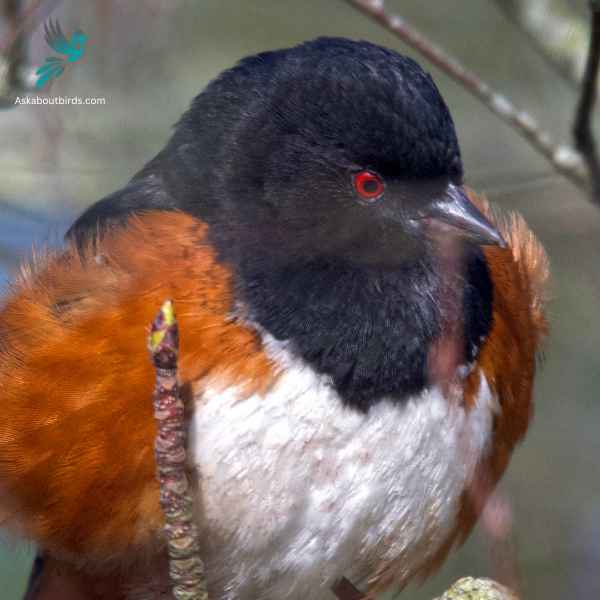
| Feature | Measurement |
|---|---|
| Scientific Name | Pipilo maculatus |
| Length | 6.7-8.3 in |
| Wingspan | 11.0 in |
| Weight | 33 g |
The Spotted Towhee is a distinctive songbird commonly found in the shrubby undergrowth and thickets of the western parts of North America. Its song, a series of melodious chirps, often punctuates the early morning air.
Appearance: Male Spotted Towhees showcase a coal-black head, throat, and upper body contrasted with rufous sides and a white belly. Their wings and back are dark but adorned with white spots, hence their name. Females have a similar pattern but are more brownish than black.
Diet: Spotted Towhees primarily feed on a mixture of insects and seeds. They often forage on the ground, scratching through leaf litter to uncover beetles, ants, and other insects, as well as various seeds and berries.
Reproduction: Spotted Towhees usually nest on the ground, concealed by dense vegetation or sometimes in low shrubs. The female builds the nest and lays a clutch of 3 to 5 eggs. She incubates the eggs, while the male stands guard and both parents partake in feeding the fledglings after hatching.
Red-breasted Nuthatch

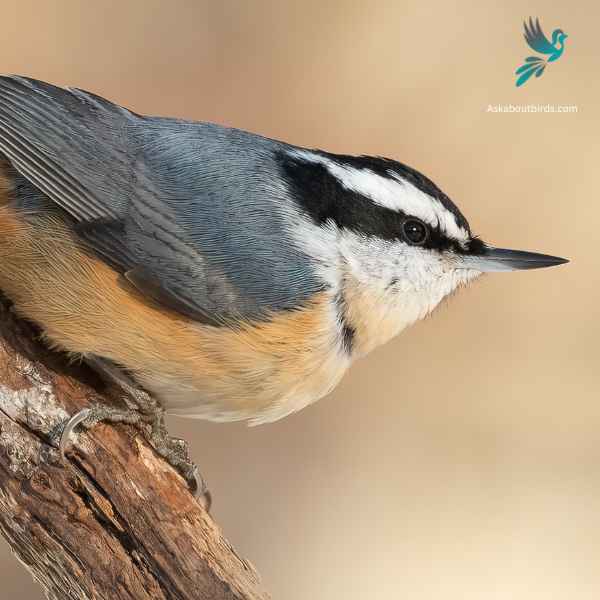
| Feature | Measurement |
|---|---|
| Scientific Name | Sitta canadensis |
| Length | 4.3–4.7 in |
| Wingspan | 8.3 in |
| Weight | 0.3–0.5 oz |
The Red-breasted Nuthatch is a small, agile songbird, known for its ability to move headfirst down tree trunks while searching for food.
Appearance: This bird boasts a slate-blue back and a pale rust-red underside. A prominent black stripe runs through the eye and is bordered above by a white eyebrow. Their sharp, pointed bill is characteristic of the species.
Diet: Red-breasted Nuthatches primarily feed on insects and seeds, especially those from coniferous trees. They have a fondness for large seeds, which they wedge into bark crevices to hack open with their bills.
Reproduction: These birds construct nests in natural tree cavities or abandoned woodpecker holes, often lining the entrance with resin. This is thought to deter predators or competitors from entering. The female typically lays a clutch of 5 to 6 eggs, and both parents partake in feeding the chicks once they hatch.
Bullock’s Oriole

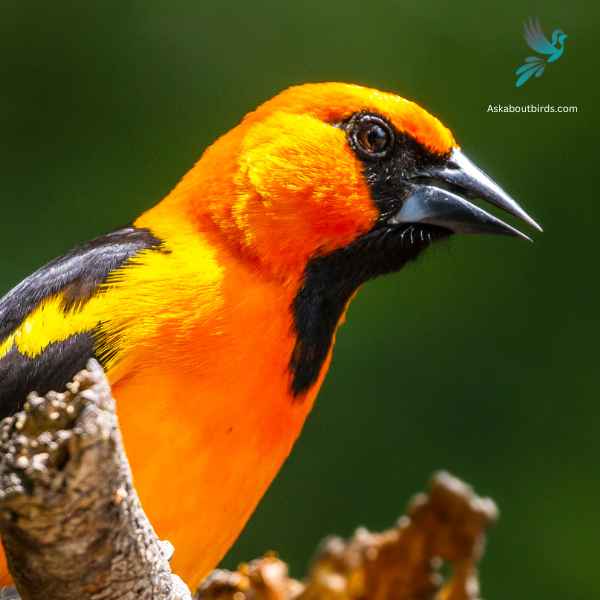
| Feature | Measurement (Imperial) |
|---|---|
| Scientific Name | Icterus bullockii |
| Length | 7.5-8.5 inches |
| Wingspan | 11.8-12.6 inches |
| Weight | 0.9-1.2 oz |
The Bullock’s Oriole is a bright and lively songbird, known for its stunning contrasting colors and vibrant melodies, predominantly found across the western regions of North America.
Appearance: The male Bullock’s Oriole boasts a brilliant orange chest, belly, and face with a black crown, eye line, throat, and back. Its wings are black with a prominent white patch and white-edged coverts. Females are more muted in coloration, displaying a yellowish-orange hue with grayish-brown wings that still retain the white patches.
Diet: These orioles primarily feed on insects, especially caterpillars, beetles, and grasshoppers. Apart from insects, their diet also includes fruits, berries, and nectar. They’re adept foragers, often hanging upside-down on branches to find hidden prey.
Reproduction: Bullock’s Orioles are noted for their skill in crafting hanging, woven nests, often positioned on the tips of slender branches, ensuring they are difficult for predators to access. Both parents partake in feeding the young, who then fledge about two weeks after hatching.
Orchard Oriole
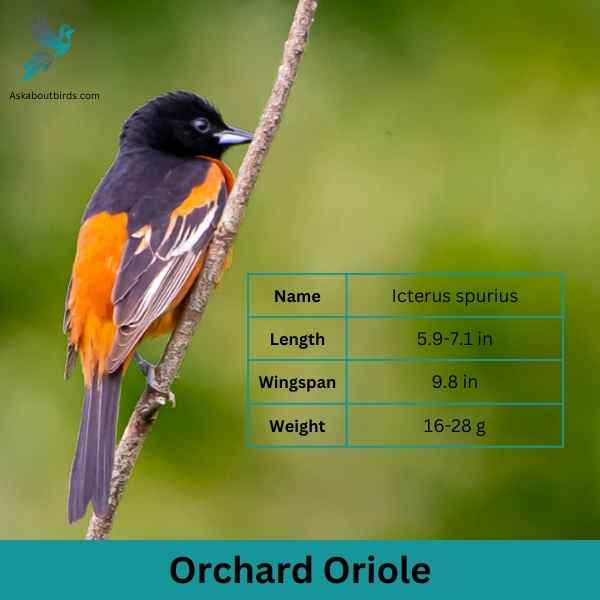
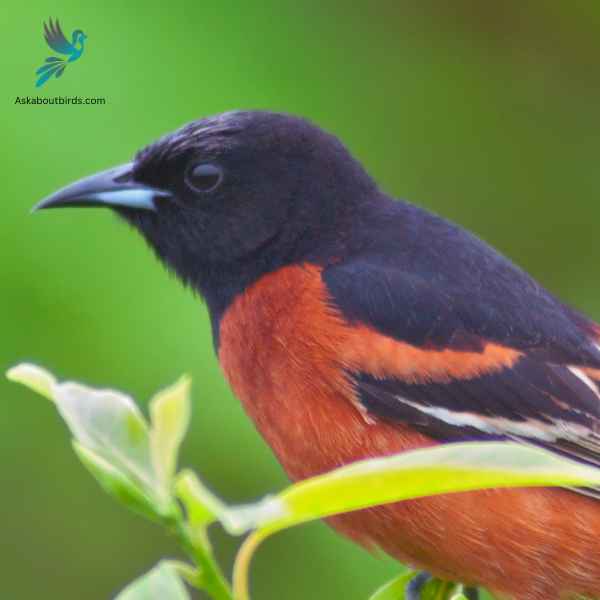
| Feature | Measurement |
|---|---|
| Scientific Name | Icterus spurius |
| Length | 5.9-7.1 in |
| Wingspan | 9.8 in |
| Weight | 16-28 g |
The Orchard Oriole is a small songbird noted for its distinctive coloration and melodic song.
Appearance: Male Orchard Orioles are a striking sight with their dark chestnut body and black head and black and white wings, while females and immature males are olive-green and feature a yellowish underpart. The species is often recognized by its slender body and pointed bill.
Diet: The diet of the Orchard Oriole consists primarily of insects, fruits, and nectar. They are adept at catching insects mid-air and are also known to sip nectar from flowers, aiding in pollination. When fruits are in season, they make up a substantial portion of the bird’s diet.
Reproduction: Orchard Orioles often nest in open woodlands and orchards, hence their name. The female is responsible for building the nest, typically choosing a location in a tree or shrub. The female lays a clutch of 4 to 6 eggs, which she incubates for about two weeks.
Vermilion Flycatcher
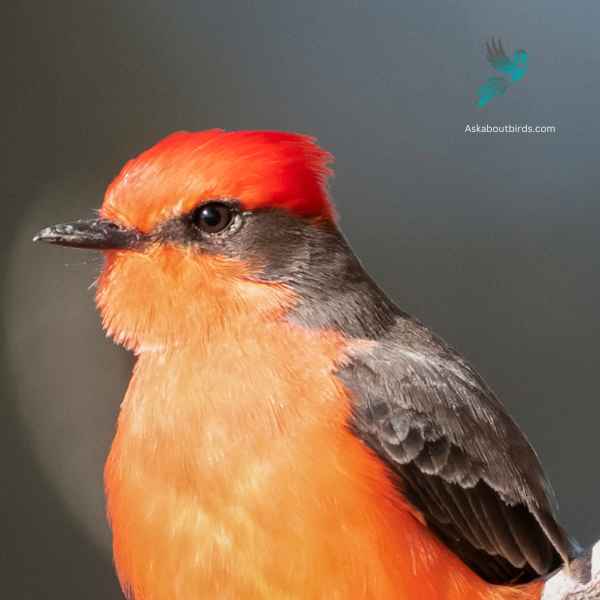

| Feature | Measurement |
|---|---|
| Scientific Name | Pyrocephalus obscurus |
| Length | 5.1–5.5 in |
| Wingspan | 9.4 to 9.8 in |
| Weight | 11 to 14 g |
The Vermilion Flycatcher is a small and colorful bird native to the Americas. The male Vermilion Flycatcher is a striking sight, displaying a vibrant red plumage on its head, breast, and underparts, contrasting with its brown wings and black tail below. Females, on the other hand, have more muted colors, featuring a pale yellowish belly and grayish-brown upperparts.
Vermilion Flycatchers are known for their lively and acrobatic flight displays, which they perform during courtship or to defend their territories. They often sing a series of soft, whistled notes while engaged in these aerial displays. They construct cup-shaped nests, usually in shrubs or low trees, where females lay their eggs and raise their young.
Western Tanager

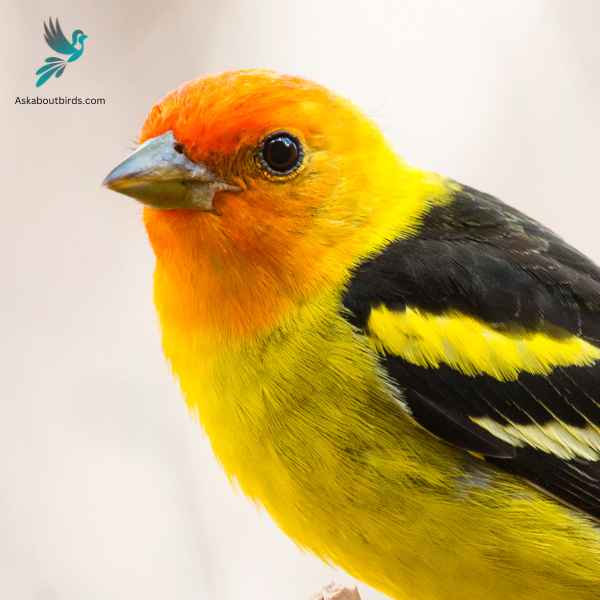
| Feature | Measurement |
|---|---|
| Scientific Name | Piranga ludoviciana |
| Length | 6.3-7.5 in |
| Wingspan | 11.5 in |
| Weight | 24-36 g |
The Western Tanager is a vibrant songbird that graces the forests and woodlands of the western regions of North America, enchanting observers with its colorful plumage and melodious song.
Appearance: The male Western Tanager is renowned for its bright yellow body contrasted with a striking red head and black wings and tail. The females are more subdued in hue, primarily being yellow with grayish wings and back, and lacking the brilliant red head of the males.
Diet: Western Tanagers primarily feed on insects, especially when breeding, but they also incorporate a significant amount of fruits and berries into their diet, especially during migration and winter.
Reproduction: Western Tanagers build their nests high in coniferous trees, often well concealed from potential predators. The female usually lays a clutch of 3 to 5 eggs and takes the primary role in incubation, while both parents are involved in feeding the chicks after they hatch.
American Robins


| Feature | Measurement |
|---|---|
| Scientific Name | Leptotila plumbeicep |
| Length | 10.6-11.8 in |
| Wingspan | — |
| Weight | 160-200 g |
The American Robin is a widely recognized bird species known for its melodious song and early bird tendencies.
Appearance: American Robins are medium-sized birds with a distinctive appearance. Both males and females sport a gray to brown back and a warm red to orange breast and belly and gray wings. They also have a characteristic white eye-ring and a black head, but males are usually darker than females.
Diet: American Robins have a diverse diet that changes depending on the season. In summer, they feed heavily on earthworms, beetles, and other invertebrates, which they catch on the ground. During winter, they mostly eat fruits and berries.
Reproduction: American Robins usually build their nests in trees or shrubs, but they are also known to nest on human-made structures. The female lays a clutch of about 3 to 5 eggs, which she incubates for about 12 to 14 days.
Barn Swallow

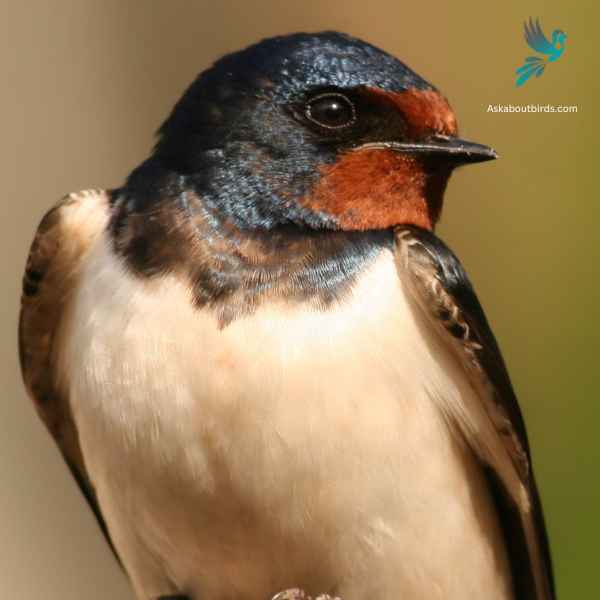
| Feature | Measurement |
|---|---|
| Scientific Name | Hirundo rustica |
| Length | 6.5–7.5 in |
| Wingspan | 12.5–13.5 in |
| Weight | 16–22 g |
The Barn Swallow is a sleek, agile bird renowned for its graceful flight patterns and iconic forked tail, often seen darting over fields and water bodies in search of flying insects.
Appearance: Barn Swallows have deep blue, almost iridescent, upperparts and a rufous to tawny underbelly. Their distinctively forked tail and long wings give them a streamlined look. Both males and females have a similar appearance, though males often exhibit slightly brighter colors and a deeper fork in the tail.
Diet: Barn Swallows feed primarily on flying insects, which they catch in mid-air during their agile and acrobatic flights. Their diet includes flies, beetles, moths, and other small flying insects.
Reproduction: Barn Swallows are known for building their mud nests on man-made structures, particularly barns, bridges, and eaves. The nest is cup-shaped and made from mud pellets, often lined with feathers. The female lays a clutch of 4 to 6 eggs.
Northern Flicker

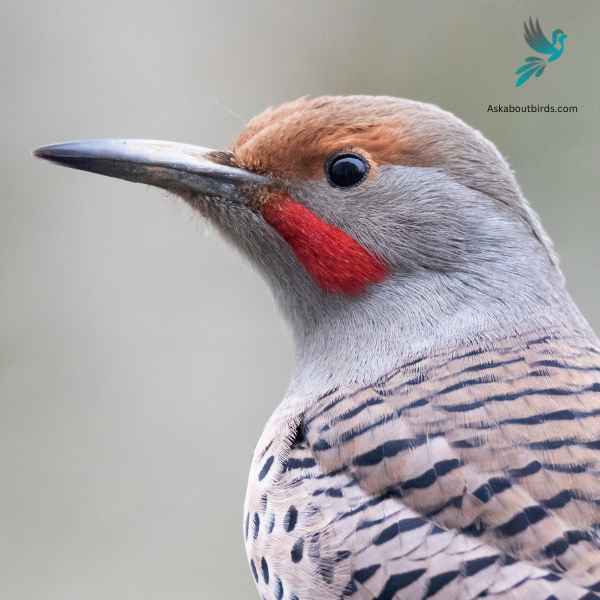
| Feature | Measurement |
|---|---|
| Scientific Name | Colaptes auratus |
| Length | 11–12 in |
| Wingspan | 17–20 in |
| Weight | 3.9–5.6 oz |
The Northern Flicker is a medium-sized woodpecker, recognized by its unique patterns and coloring, often found drumming on trees or foraging on the ground across North America.
Appearance: The Northern Flicker stands out with its grayish brown body, black-scalloped plumage, and a black bib. Males sport a distinctive black or red mustache stripe. Depending on the subspecies, the underwing and undertail feathers can be bright yellow or red, flashing vividly during flight.
Diet: While most woodpeckers are tree-bark foragers, the Northern Flicker prefers hunting on the ground. Its primary diet consists of ants and beetles, supplemented occasionally by fruits, berries, seeds, and other small insects.
Reproduction: Northern Flickers are cavity nesters, preferring to excavate their nesting hole in dead or diseased tree trunks. The interior of the nest is lined with wood chips.
Rufous Hummingbird


| Feature | Measurement |
|---|---|
| Scientific Name | Selasphorus rufus |
| Length | 3.1–3.9 in |
| Wingspan | 4.3 in |
| Weight | 0.1–0.2 oz |
The Rufous Hummingbird is a small, brilliantly colored bird known for its impressive migratory journeys and feisty behavior.
Appearance: The male Rufous Hummingbird boasts a gleaming orange-red body with a white chest and an iridescent red throat, called a gorget. The female has green upperparts with rufous-washed flanks and tail. Her throat may have some iridescent patches, but it’s generally whitish.
Diet: Like other hummingbirds, the Rufous Hummingbird primarily feeds on nectar from a variety of flowering plants. They also eat insects and spiders for protein, catching them in flight or plucking them from vegetation.
Reproduction: Rufous Hummingbirds nest in trees, shrubs, or even ferns. The female alone selects the site, builds the nest, and cares for the offspring.
Scott’s Oriole


| Feature | Measurement |
|---|---|
| Scientific Name | Icterus parisorum |
| Length | 7.5–8.5 in |
| Wingspan | 12.6 in |
| Weight | 1.1–1.4 oz |
The Scott’s Oriole is a strikingly colored songbird, frequently observed in the southwestern United States and Mexico, especially in areas with yucca plants.
Appearance: The male Scott’s Oriole displays a bold combination of bright yellow and glossy black. Its body and head are largely black, with a deep yellow chest, belly, and rump. The wings are black with notable white wing bars. Females and immature birds have an olive-green tint and lack the stark contrast seen in males.
Diet: Their diet consists primarily of insects, nectar, and fruit. They are particularly fond of the nectar from agave and yucca flowers, and their slender bills are well-suited for extracting it.
Reproduction: Scott’s Orioles build deep, hanging basket-like nests, often in yucca or other types of trees. These nests are typically woven with fibers from yucca or other plants. The female usually lays a clutch of 3 to 4 eggs, and she is primarily responsible for incubation, while both parents partake in feeding the young.
Hepatic Tanager
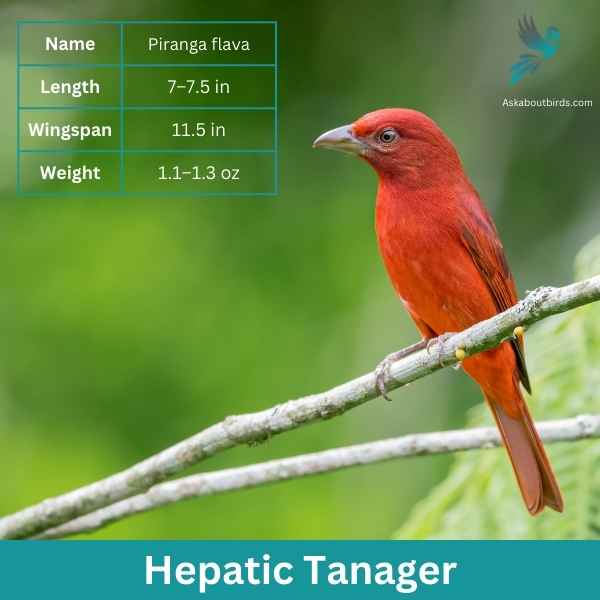
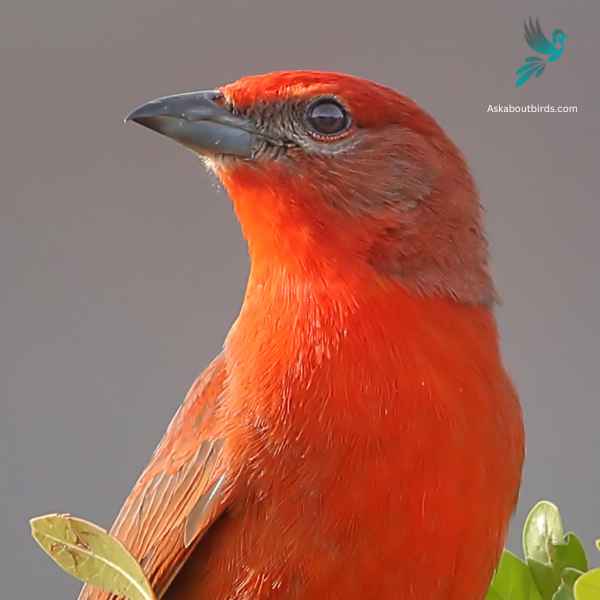
| Feature | Measurement |
|---|---|
| Scientific Name | Piranga flava |
| Length | 7–7.5 in |
| Wingspan | 11.5 in |
| Weight | 1.1–1.3 oz |
The Hepatic Tanager is a robust and brightly colored songbird found primarily in pine-oak woodlands of the American Southwest and Mexico.
Appearance: Male Hepatic Tanagers are a rich reddish-brown or “liver” color, from which they get their name (hepatic means liver-colored). Their wings and tail are more dusky, while females are a more muted yellow-orange, with a gray back and wings. Both sexes have a stout, pointed bill.
Diet: These tanagers primarily eat insects, but they also consume a fair amount of fruit and berries. They often forage by perching quietly and then making short flights to capture prey or pluck fruit.
Reproduction: Hepatic Tanagers nest in trees, often in a concealed location such as a dense clump of needles in a pine tree. The nest is a shallow cup made of twigs, grass, and pine needles. The female typically lays a clutch of 3 to 4 pale blue or greenish eggs. Both parents share feeding duties once the eggs hatch.
Black-headed Grosbeak

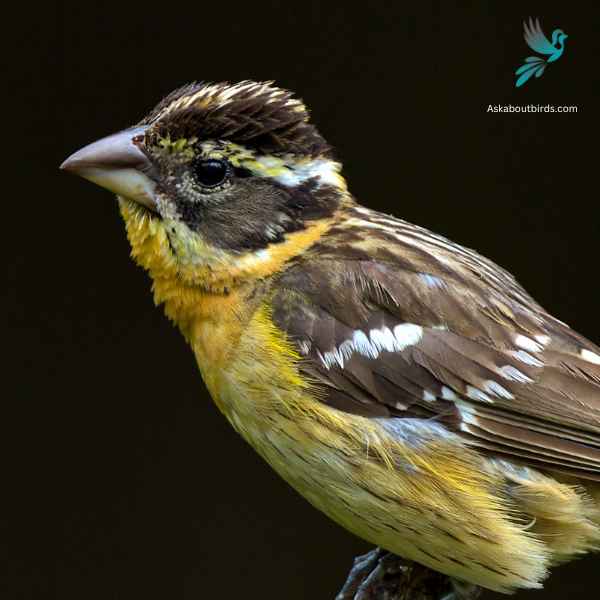
| Feature | Measurement |
|---|---|
| Scientific Name | Pheucticus melanocephalus |
| Length | 7.1–7.5 in |
| Wingspan | 12.6 in |
| Weight | 34–48 g |
The Black-headed Grosbeak is a vibrant songbird known for its melodious song, often confused with that of the American Robin but more rich and varied.
Appearance: Males are recognizable by their orange chest, black head, and black and white wings. Females, on the other hand, have a streaked brown appearance, resembling large sparrows but with hints of orange on their sides and flanks.
Diet: Black-headed Grosbeaks primarily feed on insects, seeds, and fruits. They are especially fond of beetles and caterpillars, and they’re one of the few birds that can eat monarch butterflies without suffering from the toxins.
Reproduction: They often nest in deciduous trees or shrubs. The nest is a loose, cup-like structure made from twigs and grasses. The female usually lays 3 to 4 eggs, which she incubates. Both parents share the responsibility of feeding the chicks.
Where to Spot New Mexico’s Orange Birds
New Mexico, with its rich tapestry of habitats, from desert plains to lush forested mountains, serves as a haven for avian enthusiasts, especially those with an affinity for orange-hued birds.
- Bosque del Apache National Wildlife Refuge: A cherished gem among birders, this refuge witnesses tens of thousands of migratory birds annually. The wetlands become a mosaic of colors with various bird species during the migratory seasons.
- Gila National Forest: Encompassing woodlands, rivers, and meadows, it’s an excellent spot to encounter the Hepatic Tanager and other southwestern specialties. The forest’s diversity offers both mountain and desert birding experiences.
- Randall Davey Audubon Center & Sanctuary: Located in Santa Fe, this sanctuary spreads over 135 acres and is home to over 190 bird species. The varying elevations provide a unique blend of habitats, attracting a diverse bird population.
- Roswell Bird Sanctuary: This lesser-known sanctuary is a hotspot for many desert-dwelling birds and is an exceptional location to observe unique avian behaviors, especially during the breeding season.
- Cibola National Forest: Spanning across grasslands, mountains, and desert, this location is a treat for birders aiming to see a vast array of species in a single visit, with many trails and vistas for optimal bird watching.
| State’s Orange Birds | Best Spots for Orange Birds |
|---|---|
| Arizona’s Orange birds | Ramsey Canyon Preserve, Patagonia-Sonoita Creek Preserve, Huachuca Mountains |
| Utah’s Orange birds | Bear River Migratory Bird Refuge, Red Cliffs Desert Reserve, Zion National Park |
| Colorado’s Orange birds | Barr Lake State Park, Rocky Mountain National Park, Comanche National Grassland |
| Oklahoma’s Orange birds | Wichita Mountains Wildlife Refuge, Salt Plains National Wildlife Refuge, Oxley Nature Center |
| Texas’s Orange birds | High Island Sanctuaries, Laguna Atascosa National Wildlife Refuge, Big Bend National Park |
FAQs on Orange Bird Species Found in New Mexico
What kind of bird has an orange head in New Mexico?
In New Mexico, the Rufous Hummingbird is a bird that features an orange or rufous-colored head, especially in males. These small, agile birds are known for their brilliant coloration and rapid wing beats, and they migrate through New Mexico, especially during late summer.
What is the bright orange bird in Mexico?
In Mexico, one of the most vibrant orange birds is the Altamira Oriole. This bird is primarily bright orange with some black on its throat, wings, and tail. The Altamira Oriole is the largest oriole species and can be found in the northeastern parts of Mexico and may also venture into southern parts of Texas. Its bright coloration and melodious song make it a standout in the forest edges regions it inhabits.
Are there any birds in New Mexico that are commonly known to visit bird feeders?
Yes, numerous bird species in New Mexico are attracted to bird feeders, especially when stocked with their favorite foods like sunflower seeds. Popular birds include finches, sparrows, and even some woodpeckers or Blackburnian warblers (look out for the dark gray back on the males).
New Mexico is home to a variety of yellow birds. Among them are the Yellow Warbler, Western Tanager, and the Lesser Goldfinch. New Mexico sees a number of migrants from Central America, especially during the migration seasons heading down from eastern north America. One notable species Hooded Orioles, which winters in Central America and breeds in the southwestern United States.




